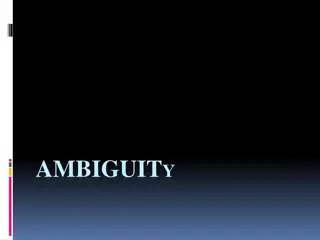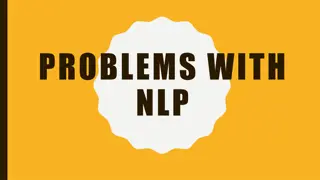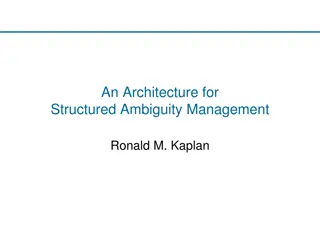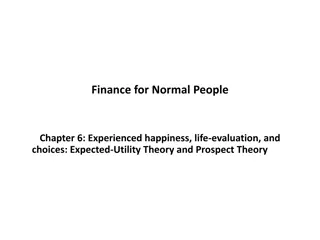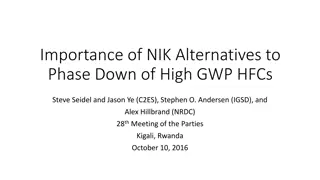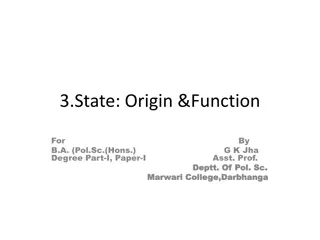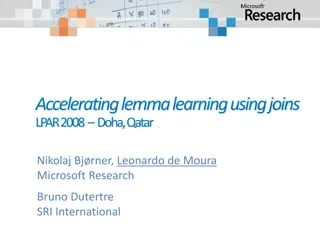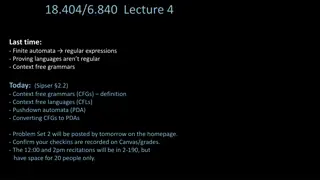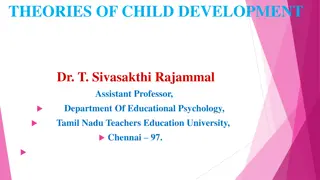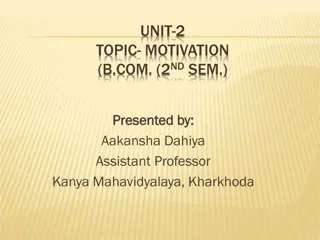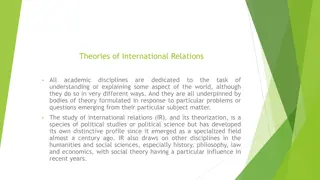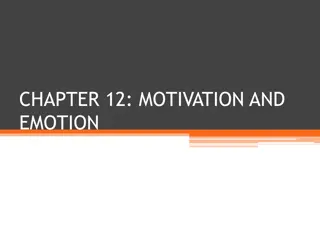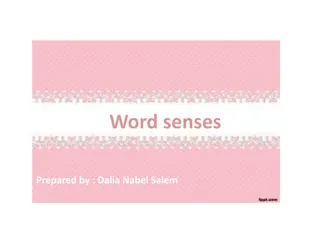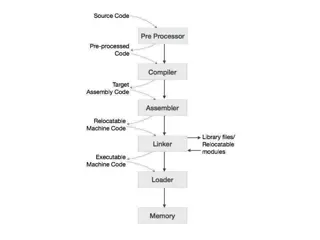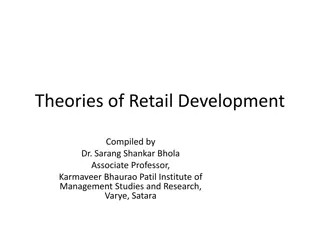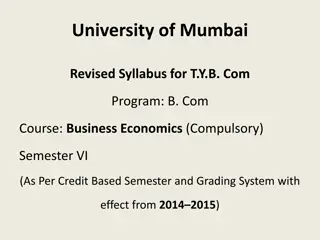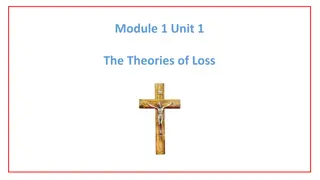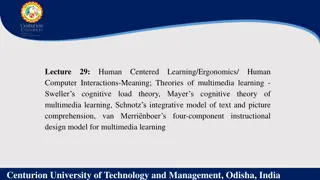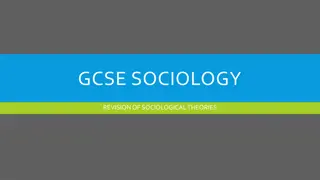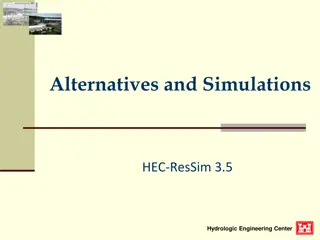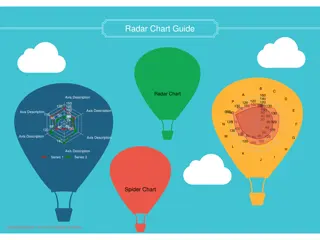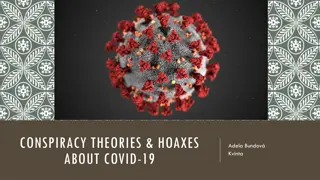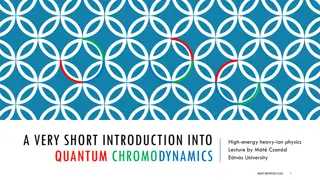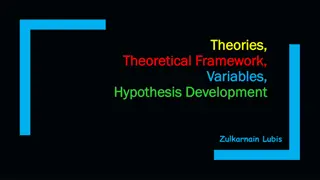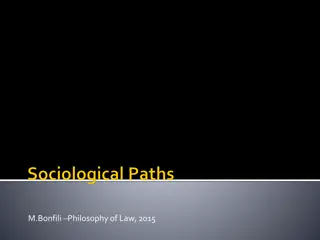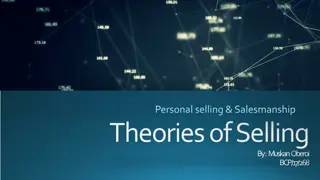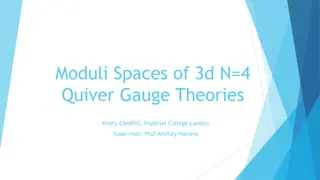Ambiguity Theories as Alternatives to Prospect Theory
This article explores ambiguity theories as alternatives to Prospect Theory, focusing on decision-making under uncertainty. It discusses the Anscombe-Aumann framework, multiple priors models, and applications of ambiguity models. The popular Anscombe-Aumann framework is detailed, with a two-stage approach involving horse races and roulette wheels. The evaluation of acts in the framework and its relation to expected utilities are also analyzed.
Download Presentation

Please find below an Image/Link to download the presentation.
The content on the website is provided AS IS for your information and personal use only. It may not be sold, licensed, or shared on other websites without obtaining consent from the author. Download presentation by click this link. If you encounter any issues during the download, it is possible that the publisher has removed the file from their server.
E N D
Presentation Transcript
Ambiguity Theories Alternative to Prospect Theory Peter P. Wakker, Erasmus School Econ., Erasmus Univ. Rotterdam, the Netherlands R&R Most ambiguity models today: theoretical; little attention for empirical findings; normatively motivated!?; focus on Ellsberg urns & ambiguity aversion (taken as rational!?); no insensitivity; me, being Bayesian (taking EU as normative), focuses on descriptive.
Outline: 1. The Anscombe-Aumann framework for decision under uncertainty; 2. Multiple priors models; 3. Multistage models with stages exogenous; 4. Multistage models with stages endogenous (smooth model); 5. Other ambiguity models; 6. Applications of ambiguity models by A-authors. 2
Popular framework for many ambiguity models today: Anscombe-Aumann (1963) (AA). Acts do not assign outcomes to states of nature, but probability distributions over prizes (e.g., prize = money amount). Is a two-stage approach: 3
1st stage: horse race 2nd stage: roulette wheel p11 . . . x11 h1 . . . . x1m p1m . . . . 1st stage (of central interest): ambiguous events (e.g. horse race.) . pn1 . . . xn1 . . . . hn xnm pnm 2nd stage (only auxiliary/artificial): roulette wheel, generates probability distributions over money. ambiguity; our central interest auxiliary structure; facilitates maths 4
AA evaluation of AA acts: Result of CE substitution: p11 . . . p1mx1m x11 h1 h1 . . . CE1 . . . . . . . . . pn1 . . . xn1 . . . . . CEn hn hn xnm pnm Ambiguity- evaluation; our central interest. CE-substitution will be done, by EU (so, backward induc- tion); auxiliary. 5
Relative to our Structural Assumption 1.2.1 (Savage s uncertainty model): Utilities of outcomes are replaced by: expected utilities of lotteries. EU in 2nd stage is linear in probability. Mathematically convenient! AA gives linear utility without linear utility. This made AA popular. 6
Two descriptive (& normative!?) problems for the auxiliary structure (2nd stage lotteries) in AA: 1. EU for risk questionable (Allais, Machina, prospect theory ). Many may defend EU for risk normatively!? 2. CE substitution (backward induction; conse- quentialism ) is very questionable for nonEU. Some defend backward induction normatively!? Natural under EU. Problematic under nonEU. Machina (1989): normative objections. 7
Others, criticizing backward induction in general under nonEU normatively: Dominiak & Lefort 2011; Eichberger & Kelsey 1996; Gul & Pesendorfer 2005; Hayashi 2011; Karni & Safra 1990; Karni & Schmeidler 1991; Machina 1989; McClennen 1990; Ozdenoren & Peck 2008; Siniscalchi 2004. Recently, leveled against AA: see keyword criticism of monotonicity in Anscombe-Aumann (1963) for ambiguity in http://personal.eur.nl/wakker/refs/webrfrncs.docx 8
The following theories can all be defined equally well in AA framework as in Savage s. Following the literature, we do the former. 9
Outline: 1. The Anscombe-Aumann framework for decision under uncertainty; 2. Multiple priors models; 3. Multistage models with stages exogenous; 4. Multistage models with stages endogenous (smooth model); 5. Other ambiguity models; 6. Applications of ambiguity models by A-authors. 10
In ambiguity, we dont know precisely the probability measure ? on ?: multiple priors models specify a set ? of possible probability measures on ?. Then models can be defined: 11
Maxmin EU (Gilboa & Schmeidler 1989). Take subjective ? and subjective set ?: ? ???????? ? . Model is pessimistic; ambiguity-averse!? Maxmax EU: take subjective ? and subjective set ?: ? ???????? ? . Model is optimistic; ambiguity-seeking!? ?-maxmin expected utility (Hurwicz 1951; Jaffray 1994; Ghirardato et al. 2004): take subjective ? and subjective set ?: ? ? ???????? ? + (1 ?) ????????(?) Size of ? is degree of ambiguity of info, and ? captures attitude, aversion/seeking to ambiguity. 12
Pros of multiple priors: 1. Set ? fits well with natural way of speaking; 2. Easy to understand upon first acquaintance; 3. Requires no new mathematics. Cons: 1. Decision rules are crude; 2. Theory as such is too rich: there are too many sets ?; 3. Endogenous (subjective) versus exogenous (objective) status of ? is problematic. * * Special cases, e.g. -contamination, are considered. 13
Generalizations: the variational model (Maccheroni, Marinacci, & Rustichini 2006): take subjective U, subjective ?, and c:? : ? ??????(?? ? + ?(?)) ? function can serve to make some ? s less influential by setting ? ? large, e.g. ? ? = . Special case & interpretation: see next slide. 14
Popular special case of variational model: robust model (Hansen & Sargent 2001): ? ? is relative entropy (sort of distance) of ? with respect to some focal probability ?. ? is what you believe primarily. But if another ? gives deviations so bad that it is much worse (by more than ?(?)), then you go by ? rather than by ?. Popular in statistics. They sell well in macroeconomics as model uncertainty. Popular in expert aggregation and climate change. 15
Outline: 1. The Anscombe-Aumann framework for decision under uncertainty; 2. Multiple priors models; 3. Multistage models with stages exogenous; 4. Multistage models with stages endogenous (smooth model); 5. Other ambiguity models; 6. Applications of ambiguity models by A-authors. 16
Not to be confused with two-stage of AA, where 2nd stage is purely auxiliary/artificial add-on. Here extra stage is essential part of ambiguity. Imagine unknown Ellsberg urn: 100 balls, red/black, unknown proportion. $100 if drawn ball red, $0 otherwise: 100?0. 17
Red$100 p=0 0 red balls p=1 Then what is the big deal here?? Is just ?=0 ?? $100 by multiplication rule (called reduction of compound lotteries, RCLA)???? Well People give up RCLA! Can then do backward induction with nonEU. Can get extra pessimism in 2ndstage: ambiguity aversion. Black$0 ? ? 100 probability at Red$100 p=0.01 1 red ball p=0.99 Black$0 . . . . . . Is old idea: Becker & Brownson (1964), Yates & Zukowski (1976), G rdenfors & Sahlin (1982), Segal (1987), Halevy (2007), Ergin & Gul (2009). . . Red$100 p=1 100 red balls p=0 Black$0 18
Red$100 p=0 0 red balls p=1 Remarkable version: Use EU in both stages. But with different utility function in two stages. Can take more concave U in 2nd stage for extra pessimism: ambiguity aversion. Analytically convenient! Tversky & Kahneman (1975), Kreps & Porteus (1979; interpreted as time-attitude), Neilson (1993, 2010), Nau (2006). Called recursive expected utility. Black$0 Red$100 p=0.01 1 red ball p=0.99 Black$0 . . . . . . . . Red$100 p=1 100 red balls p=0 Black$0 19
Pros: 1. Intuitive; 2. Much flexibility regarding models to use in the two stages; 3. The last version mentioned (two-stage EU): mathematically convenient. Need no new software. Cons: 1. Exogenous two-stage setup to capture ambiguity rarely available in practice; 2. Backward induction questionable (as with AA); 3. 2-stage EU: modeling ambiguity through outcome-function is not homeomorphic (not psychological); this is not intuitive; 4. 2-stage EU: cannot capture insensitivity so descriptively problematic. 20
Outline: 1. The Anscombe-Aumann framework for decision under uncertainty; 2. Multiple priors models; 3. Multistage models with stages exogenous; 4. Multistage models with stages endogenous (smooth model); 5. Other ambiguity models; 6. Applications of ambiguity models by A-authors. 21
Now take two-stage setup endogenous. Directly condition on ?? s on ?, without this being a physically- defined event. Assign 2nd-stage subjective probability ?? to each ??. ?1 ... ?1 ?1 on ? . . . ?? ?? ?1 ... ?1 ?2 on ? . . . ?? . ?? Do backward induction. Violate RCLA. . . . Becker & Brownson (1964), Yates & Zukowski (1976), G rdenfors & Sahlin (1982), Segal (1987), Halevy (2007), Ergin & Gul (2009). . . . This can be a general ambiguity theory! . ?1 ... ?1 . But hard to observe Very general (Technical detail: then act on S in 2nd stage may not depend on stage, but be the same in all stages ...) . ?? on ? . ?? ?? 22
Very popular version: smooth model (Klibanoff, Marinacci, Mukerji 2004). Using EU in both stages. Endogenous version of recursive EU. 23
Discussion of smooth model Pros: (1) Is general ambiguity model. (2) Mathematical convenience (EU + smoothness). Cons: (1) Those of exogenous recursive EU (non-homeomorphic; not empirical: no insensitivity) (2) Endogenous two-stage setup is unobservable and too general. In virtually all applications, people take it: exogenous People often use smooth model nowadays (exogenous) because so convenient; awaiting more theory to come. 24
Outline: 1. The Anscombe-Aumann framework for decision under uncertainty; 2. Multiple priors models; 3. Multistage models with stages exogenous; 4. Multistage models with stages endogenous (smooth model); 5. Other ambiguity models; 6. Applications of ambiguity models by A-authors. 25
Multiple priors others: Chateauneuf (1991); Gajdos, Hayashi, Tallon, & Vergnaud (2008); Variational alternatives: Chateauneuf & Faro (2009), Strzalecki (2011): multiplier; Vector expected utility: Siniscalchi (2009); 2-stage maxmin: Jaffray (1989); Olszewski (2007); Expected Uncertain Uty Thy & Hurwicz expected utility Gul & Pesendorfer (2014, 2015) EU with uncertain probabilities: Izhakian (2017) . . . 26
Outline: 1. The Anscombe-Aumann framework for decision under uncertainty; 2. Multiple priors models; 3. Multistage models with stages exogenous; 4. Multistage models with stages endogenous (smooth model); 5. Other ambiguity models; 6. Applications of ambiguity models by A-authors. 27
Applications of ambiguity theories with A-authors (2018) Contract theory Amarante, Massimiliano, Mario Ghossoub, & Edmund Phelps (2017) Contracting on Ambiguous Prospects, Economic Journal 127, 2241 2246. General equilibrium theory: Araujo, Aloisio, Alain Chateauneuf, Juan Pablo Gama, & Rodrigo Novinski (2018) General Equilibrium with Uncertainty Loving Preferences, Econometrica 86, 1859 1871. Game theory: Ahn, David S. (2007) Hierarchies of Ambiguous Beliefs, Journal of Economic Theory 136, 286 301. Aryal, Gaurab & Ronald Stauber (2014) Trembles in Extensive Games with Ambiguity Averse Players, Economic Theory 57, 1 40. Insurance: Alary, David, Christian Gollier, & Nicolas Treich (2013) The Effect of Ambiguity Aversion on Insurance and Self-Protection, Economic Journal 123, 1188 1202. Welfare theory: Alon, Shiri & Gabrielle Gayer (2016) Utilitarian Preferences with Multiple Priors, Econometrica 84, 1181 1201. Asset pricing: Anderson, Evan W., Eric Ghysels, & Jennifer L. Juergens (2009) The Impact of Risk and Uncertainty on Expected Returns, Journal of Financial Economics 94, 233 263. Health: Attema, Arthur E., Han Bleichrodt, & Olivier L'Haridon (2018) Ambiguity Preferences for Health, Health Economics 27, 1699 1716. Climate change: Aydogan, Ilke, Lo c Berger, Valentina Bosetti, & Ning Liu (2018) Three Layers of Uncertainty: An Experiment, working paper. 28


